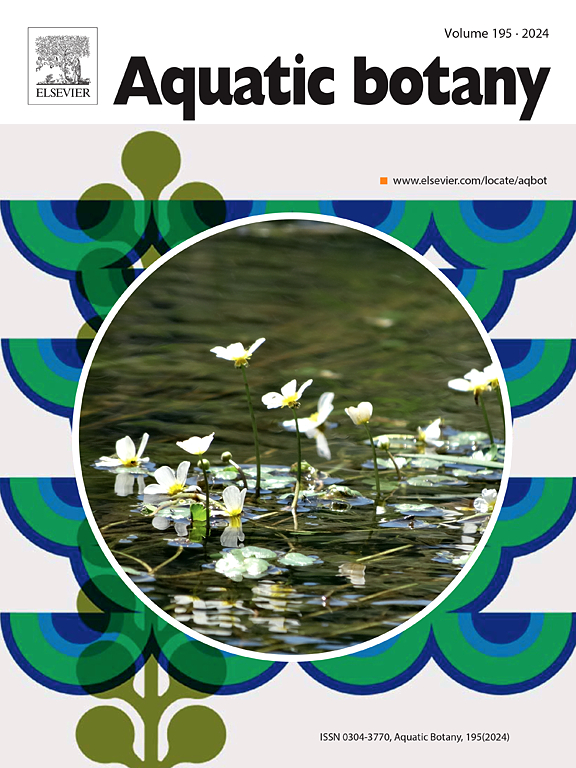Effects of desiccation time on performance of a cultured (Neopyropia yezonensis) and fouling alga (Ulva prolifera)
IF 2.6
4区 生物学
Q2 MARINE & FRESHWATER BIOLOGY
引用次数: 0
Abstract
Neopyropia yezoensis, a kind of red alga (Rhodophyta) that is a source of nori, is a highly valuable macroalga widely cultivated in coastal regions of East Asia. However, in recent years, Neopyropia cultivation areas have been frequently disturbed by green tide algae, particularly Ulva prolifera. To address this issue, we conducted a seven-day experiment subjecting both N. yezoensis and raft-attached U. prolifera to desiccation treatment twice daily, with exposure times ranging from 0 to 6 hours per treatment. The physiological responses were evaluated through microscopic structure analysis, maximum quantum yield of photosystem II (Fv/Fm), biomass measurements, and pigment content determination. Results showed that increasing desiccation time significantly affected the physiological status of U. prolifera. With prolonged desiccation time, both U. prolifera and N. yezoensis exhibited decreased Fv/Fm values, reduced biomass growth rate, and significant changes in pigment content. Desiccation periods of 5–6 hours reduced the photosynthetic efficiency of photosystem II (PSII) in U. prolifera. Although a single desiccation treatment temporarily inhibited the physiological status of N. yezoensis, after undergoing desiccation–rehydration cycles, the alga not only recovered its physiological function but also exhibited higher Fv/Fm values than the continuously submerged control group. However, for treatments with desiccation times exceeding 5 hours, productivity was somewhat affected, with the growth rate being approximately 24 % lower than that of the continuously submerged group. This indicates that desiccation-rehydration cycles promote the physiological status and biomass of N. yezoensis, demonstrating its superior adaptation to desiccation conditions. This study identified 5 hours as the optimal desiccation duration for N. yezoensis cultivation. Under these conditions, N. yezoensis maintained high growth rates and favorable physiological status while effectively inhibiting U. prolifera growth, providing a viable method for controlling U. prolifera in cultivation areas.
干燥时间对培养藻(Neopyropia yezonensis)和污染藻(Ulva prolifera)性能的影响
紫红藻(Neopyropia yezoensis)是一种红藻(Rhodophyta),是海苔的来源,是东亚沿海地区广泛种植的一种极具价值的大型藻类。然而,近年来,绿潮藻,特别是增生Ulva藻,频繁干扰了新水藻养殖区。为了解决这一问题,我们进行了为期7天的实验,将叶绿梭菌和附着在木筏上的增殖梭菌每天进行两次干燥处理,每次处理的暴露时间从0到6 小时不等。通过微观结构分析、光系统II最大量子产率(Fv/Fm)、生物量测量和色素含量测定来评估生理反应。结果表明,增加干燥时间对增菌菇的生理状态有显著影响。随着干燥时间的延长,浒苔和叶藻的Fv/Fm值降低,生物量生长率降低,色素含量变化显著。5 ~ 6 小时的干旱期降低了藻光系统II (PSII)的光合效率。虽然单次脱水处理暂时抑制了叶藻的生理状态,但经过脱水-复水化循环后,叶藻不仅恢复了生理功能,而且Fv/Fm值也高于连续浸泡的对照组。然而,当脱水时间超过5 小时时,生产力受到一定影响,其生长速度比连续浸泡组低约24 %。这表明,干燥-复水循环促进了叶藻的生理状态和生物量,显示了叶藻对干燥条件的优越适应性。本研究确定了5 小时为叶藻培养的最佳干燥时间。在此条件下,叶绿梭菌保持了较高的生长速率和良好的生理状态,同时有效抑制了增毒乌菌的生长,为防治增毒乌菌提供了可行的方法。
本文章由计算机程序翻译,如有差异,请以英文原文为准。
求助全文
约1分钟内获得全文
求助全文
来源期刊

Aquatic Botany
生物-海洋与淡水生物学
CiteScore
3.80
自引率
5.60%
发文量
70
审稿时长
6 months
期刊介绍:
Aquatic Botany offers a platform for papers relevant to a broad international readership on fundamental and applied aspects of marine and freshwater macroscopic plants in a context of ecology or environmental biology. This includes molecular, biochemical and physiological aspects of macroscopic aquatic plants as well as the classification, structure, function, dynamics and ecological interactions in plant-dominated aquatic communities and ecosystems. It is an outlet for papers dealing with research on the consequences of disturbance and stressors (e.g. environmental fluctuations and climate change, pollution, grazing and pathogens), use and management of aquatic plants (plant production and decomposition, commercial harvest, plant control) and the conservation of aquatic plant communities (breeding, transplantation and restoration). Specialized publications on certain rare taxa or papers on aquatic macroscopic plants from under-represented regions in the world can also find their place, subject to editor evaluation. Studies on fungi or microalgae will remain outside the scope of Aquatic Botany.
 求助内容:
求助内容: 应助结果提醒方式:
应助结果提醒方式:


